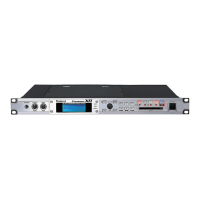32
Overview of the Fantom-XR
The Fantom-XR has two modes; Patch mode and Performance mode.
Use the mode that’s most appropriate for the way you’re playing.
Patch mode—playing or creating
an individual sound
In Patch mode you can use a connected keyboard or other device to
play a single Patch (p. 33) on the Fantom-XR. Since Patch mode lets
you use a variety of effects on a single patch, you can play very rich
textures.
In Patch mode it’s also easy to edit the selected sound, so this is the
mode to use when editing or creating your own sounds.
Performance mode—playing
multiple sounds/creating songs
In Performance mode you can use multiple patches or rhythm sets
simultaneously. A performance (p. 33) contains sixteen “Parts.” You
can assign a patch or rhythm set to each part, and use them as an
ensemble, or layer sounds to create rich textures.
Since in Performance mode you can use an external MIDI device or
sequencer software to independently control each of the Fantom-
XR’s sixteen parts, this is the mode to use when you’re creating a
song.
* When the Fantom-XR is shipped from the factory, Patch mode is
selected. If you leave the Fantom-XR in Patch mode and play back
song data from an external MIDI device or sequencer software, you
will hear only one Part of the song. In such cases, you’ll need to switch
the Fantom-XR to Performance mode.
For details on switching between Patch mode and Performance
mode, refer to p. 37.
When using the Fantom-XR, you will notice that a variety of
different categories come into play when working with sounds.
What follows is a simple explanation of each sound category.
Tones
On the Fantom-XR, the tones are the smallest unit of sound.
However, it is not possible to play a tone by itself. The patch is the
unit of sound which can be played, and the tones are the basic
building blocks which make up the patch.
fig.04-002.e
Tones consist of the following five components.
WG (Wave Generator)
Specifies the PCM waveform (wave) that is the basis of the sound,
and determines how the pitch of the sound will change.
The Fantom-XR has 1,480 different waveforms. All patches built into
the Fantom-XR consist of combinations of tones which are created
based on these waveforms.
There are four wave generators for each rhythm tone
(percussion instrument sounds).
TVF (Time Variant Filter)
Specifies how the frequency components of the sound will change.
TVA (Time Variant Amplifier)
Specifies the volume changes and the sound’s position in a stereo
soundfield.
Envelope
You use Envelope to initiate changes to occur to a sound over time.
There are separate envelopes for Pitch, TVF (filter), and TVA
(volume). For example if you wish to modify the way in which the
sound attacks or decays over time, you would adjust the TVA
envelope.
Patch mode and
Performance mode
How the Fantom-XR Is Organized
Classification of Fantom-XR Sound
Types
WG
Pitch
Envelope
TVF
TVF
Envelope
TVA
Envelope
TVA
LFO 1 LFO 2
control signal
Tone
audio signal
Fantom-XR_r_e.book 32 ページ 2006年4月4日 火曜日 午前10時14分

